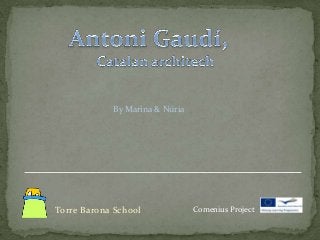
Antoni Gaudí, by Marina & Nuria
- 1. Torre Barona School By Marina & Núria Comenius Project
- 2. Antoni Gaudí,Reus 25th June 1852-Barcelona,10th June 1926 Antoni Gaudí Antoni Gaudí was a Spanish Catalan architect and figurehead of Catalan Modernism. Gaudí's works reflect his highly individual and distinctive style and It is largely concentrated in the Catalan capital of Barcelona, notably his magnum opus, the Sagrada Família (Holly Family). Much of Gaudí's work was marked by his big passions in life: architecture , nature, religion. Gaudí studied every detail of his creations, integrating into his architecture a series of crafts in which he was skilled:ceramics, stained glass, wrought ironwork forging and carpentry. He introduced new techniques in the treatment of materials, such as,” trencadís” made of waste ceramic pieces.
- 3. Located in the city of Barcelona, the Park Güell is one of the most beautiful icons of the city. It's a work of Antoni Gaudí located in the upper part of Barcelona, which has wonderful views of the city. You can enjoy a fantastic green walk surrounded by modernist works.
- 4. Casa Vicens This is Gaudí’s first important building. Built between 1883 and 1888, Casa Vicens is an imaginative residential project made for a rich family that owned a ceramic factory. This is clearly reflected in the “trencadis” façade that contains a big variety of ceramic decorations. You can also see some Islamic architecture influences in its façade and in some of its rooms. La Pedrera This is one of Gaudí’s main residential buildings and one of the most imaginative houses in the history of architecture. This building is more a sculpture than a building. The façade is a varied and harmonious mass of undulating stone that, along with its forged iron balconies, explores the irregularities of the natural world. UNESCO recognized this building as World Heritage in 1984. Casa Batlló Casa Batlló is the result of a total restoration in 1904 of an old conventional house built in 1877. Gaudí used for it the typical constructive elements of the Modernisme (Catalan Art Nouveau) that include ceramics, stone and forged iron. Even though it was highly criticized by the city during construction for its radical design that broke all the bylaws of the city, in 1906 it was awarded by the Barcelona City Council as one of the three best buildings of the year.
